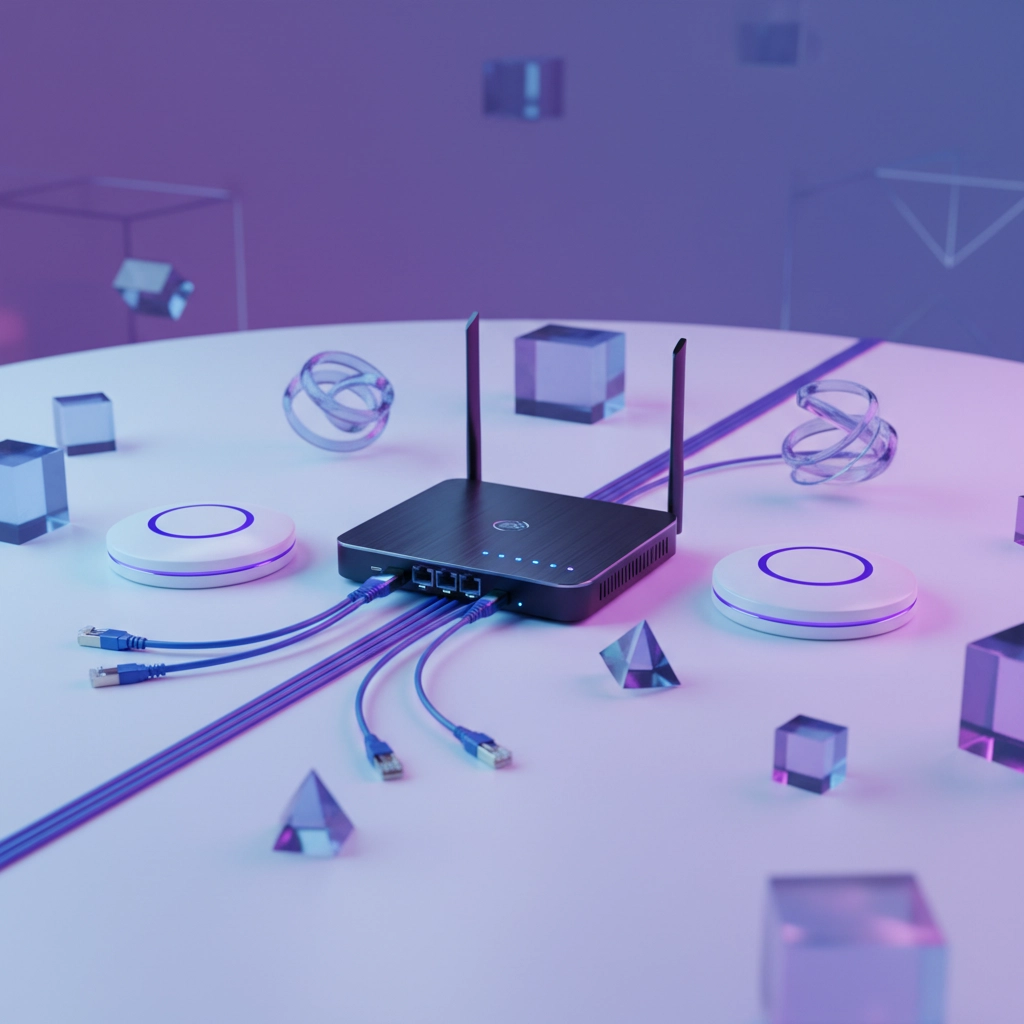Nothing kills the dinner rush vibe quite like customers waving their phones in the air hunting for a Wi-Fi signal, or worse, your POS system crashing when you've got a line out the door. Restaurant Wi-Fi problems aren't just annoying; they're business killers that can cost you customers, revenue, and your sanity.
After working with countless restaurant owners, we've seen the same Wi-Fi headaches pop up again and again. The good news? Most of these issues have straightforward fixes that won't break your budget. Let's dive into the seven most common restaurant Wi-Fi problems and how to solve them once and for all.
1. Network Overload During Peak Hours
The Problem: Your Wi-Fi works perfectly fine at 2 PM on a Tuesday, but come Friday night at 7 PM, everything grinds to a halt. This happens because your network is trying to juggle dozens of devices simultaneously, POS systems, staff phones, customer devices, security cameras, and smart kitchen equipment all competing for the same bandwidth.
The Fix: First, upgrade your internet plan to handle the demand. Most restaurants need significantly more bandwidth than they think, especially during peak hours. But throwing more bandwidth at the problem isn't always the complete solution.
Implement Quality of Service (QoS) settings on your router to prioritize critical business systems over guest Wi-Fi. This means your POS system gets first dibs on bandwidth, while social media browsing takes a back seat. Most business-grade routers include QoS features that let you allocate specific amounts of bandwidth to different types of traffic.
Consider setting up separate networks for different purposes: one for critical business operations, another for staff devices, and a third for guest access. This separation prevents customers streaming videos from affecting your ability to process payments.
2. Cheap Consumer Equipment That Can't Handle the Heat
The Problem: That $50 router from the electronics store might work great in your living room, but it'll crumble under restaurant pressure. Consumer routers aren't designed to handle 50+ simultaneous connections while dealing with the heat, grease, and electrical interference of a commercial kitchen.
The Fix: Invest in business-grade networking equipment. Yes, it costs more upfront, but it'll save you money and headaches in the long run. Look for routers that support the latest Wi-Fi 6 (802.11ax) standard, which handles multiple connections much more efficiently than older technologies.

Business-grade equipment also includes better antennas, more powerful processors, and enhanced cooling systems. Plus, they typically come with better support and warranty options: crucial when you can't afford downtime during dinner service.
3. Dead Zones Where Wi-Fi Goes to Die
The Problem: Your router works great near the host stand, but good luck getting a signal in the back booth or upstairs dining area. Dead zones are Wi-Fi's biggest enemy, and in restaurants, they're often caused by thick walls, metal kitchen equipment, or simply poor router placement.
The Fix: Start with router placement. That back office might seem like a logical spot, but it's probably the worst place for coverage. Position your main router in a central, elevated location away from metal objects and thick walls.
For larger spaces or multi-level restaurants, you'll need multiple access points or a mesh network system. Mesh systems create a unified network using multiple nodes throughout your space, automatically handing devices off to the strongest signal as they move around.
Before installing anything, conduct a site survey using a Wi-Fi analyzer app on your phone. Walk around your entire restaurant and map out signal strength in different areas. This will show you exactly where you need additional coverage.
4. Electronic Interference from Kitchen Equipment
The Problem: Microwaves, industrial ovens, and other kitchen equipment operate on similar frequencies as Wi-Fi, creating interference that can knock your network offline or drastically slow speeds. Even something as simple as a cordless phone can cause problems.
The Fix: Use a Wi-Fi analyzer to identify interference sources and crowded channels. Most routers automatically select a channel, but in busy commercial areas, this can lead to conflicts with neighboring networks.
Manually select less congested channels, particularly in the 5 GHz band, which has more available channels and typically less interference than the 2.4 GHz band. Wi-Fi 6E routers can access the even cleaner 6 GHz band, providing more space with fewer competing signals.

Position your router and access points away from major interference sources. If possible, keep them out of the kitchen entirely or use directional antennas to focus signals away from equipment that causes problems.
5. Security Holes That Put Your Business at Risk
The Problem: Restaurant Wi-Fi networks are attractive targets for hackers because they typically have weak security and handle payment information. A security breach doesn't just risk customer data: it can shut down your business and damage your reputation permanently.
The Fix: Never, ever leave your Wi-Fi network open or use default passwords. Implement WPA3 encryption (or WPA2 if WPA3 isn't available) with strong, unique passwords that you change regularly.
Most importantly, separate your internal business network from guest Wi-Fi. Your POS systems, office computers, and security cameras should be on a completely different network from what customers use. This way, even if someone compromises your guest network, they can't access your critical business systems.
Set up a proper guest portal that requires some form of authentication: whether it's a simple password, email signup, or terms acceptance. This creates a legal barrier and helps track network usage.
6. Complete Outages During Your Busiest Times
The Problem: Murphy's Law strikes again: your Wi-Fi always seems to crash during the lunch rush or Saturday night dinner service. When your POS system goes down, every minute feels like an hour, and you're losing money with every table that can't order or pay.
The Fix: Develop a systematic troubleshooting approach for quick recovery. First, determine if the problem is with your Wi-Fi network or your internet connection entirely. Check if devices connected via ethernet cable still work: if they do, it's a Wi-Fi issue, not an internet outage.
For most temporary glitches, the classic "turn it off and on again" approach works. Unplug your modem and router, wait 30 seconds, then plug the modem back in first, followed by the router after another 30 seconds.

Keep firmware updated on all networking equipment. Most business routers allow you to schedule automatic updates during off-hours to prevent disruptions during service. Regular maintenance, including periodic restarts, can prevent many issues before they occur.
Consider having a backup internet connection through a different provider or mobile hotspot device that can keep essential systems running during outages.
7. Guest Wi-Fi That Creates More Problems Than Solutions
The Problem: Your guest Wi-Fi system is supposed to make customers happy, but instead it's slowing down your business operations and creating customer service headaches. Complicated login processes frustrate customers, while unlimited guest access bogs down your network.
The Fix: Implement bandwidth limits for guest users to prevent any single user from hogging all your internet capacity. Most business routers allow you to set per-user or total guest bandwidth limits.
Create a simple, fast guest portal that doesn't require customers to jump through hoops. A simple password or one-click terms acceptance works better than complicated registration processes that most people will abandon anyway.
Use time-based access controls to automatically disconnect guest devices after a reasonable period, preventing long-term network congestion from devices that customers have forgotten about.
Set up traffic prioritization that always gives your business systems priority over guest traffic. Your POS system processing a payment should never have to wait for someone's Instagram stories to load.
Putting It All Together
Most restaurant Wi-Fi problems come down to three core issues: inadequate equipment, poor network design, and lack of ongoing maintenance. The solutions don't have to be complicated or expensive, but they do require planning and proper implementation.
Regular monitoring and maintenance are just as important as the initial setup. Networks need periodic attention to perform optimally as your business grows and technology evolves.
If you're dealing with persistent Wi-Fi issues that these solutions don't resolve, it might be time to bring in professional help. A thorough network assessment can identify problems you might not have considered and recommend solutions tailored to your specific restaurant layout and needs.
Remember, your Wi-Fi network isn't just a customer amenity anymore: it's critical business infrastructure that affects everything from payment processing to inventory management. Treating it as such will save you money, improve customer satisfaction, and let you focus on what you do best: running a great restaurant.
For restaurants in the Toronto area looking for comprehensive IT support that goes beyond basic Wi-Fi fixes, our restaurant and hospitality IT solutions are designed specifically for the unique challenges of the food service industry.